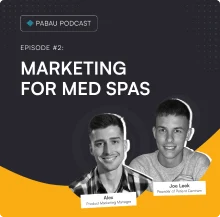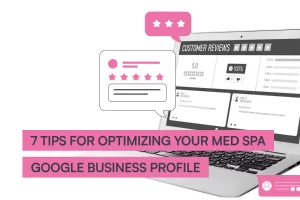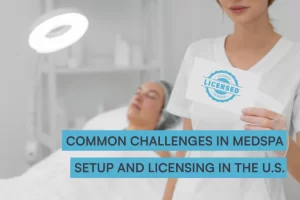Crossing your fingers and hoping that your business will show up in search results won’t work, unfortunately. We wish it did!
Establishing a solid online presence is, therefore, a must for businesses, especially aesthetic clinics.
Search Engine Optimization (SEO) is a key factor in achieving this.
SEO focuses on improving visibility on search engines such as Google, Bing, and Yahoo.
By optimizing your clinic’s website’s content, structure, and on-page elements, you can improve your rankings for specific search terms related to the services you offer. That way, when a prospective client types into Google, your business is more likely to appear.
And in a market as competitive as the beauty and wellness one, a well-planned SEO strategy of your aesthetic clinic can attract more clients who are actively looking for aesthetic treatments, preventing them from choosing your competitors instead.
Why should aesthetics clinics invest in SEO?
Search engine optimization (SEO) is a highly effective digital marketing channel for aesthetics clinics, especially in generating local leads.
When potential customers search for services a local aesthetics clinic provides, it indicates a strong intention to purchase.
This sets SEO apart from social media or email marketing, where the timing of a potential client’s interest in a facelift treatment is unpredictable.
Aesthetics clinics can benefit significantly from search engine optimization because of the following key reasons:
Appearing in local search results
Clinics should prioritize local search optimization to enhance their visibility in their local area. By optimizing their online presence for local search, clinics can ensure that their information appears prominently in search results for medical services in their geographical area.
This means ensuring all the online information is up to date, like accurate contact information (phone number and email address), operating hours, and location details. Using specific keywords on the website can also help with this.
The end goal is to make sure your clinic shows up at the top of the search results when people nearby search for aesthetic services.
Bringing in ready-to-buy customers
You can promote your treatments and special offers on social media and other channels. However, the customers who are most likely to purchase from you are the ones who come to you when they’re ready to do so. They can accomplish that with the help of SEO.
SEO is a wise choice for sustaining your clinic’s growth over time. Unlike temporary boosts from paid ads or traditional marketing like magazine ads, investing in SEO can attract new patients not just now, but for months or even years to come, provided it’s executed well.
Supporting other marketing efforts
Investing in SEO can help you create a cohesive marketing strategy. The topics that you’re writing about on your website (in a long-form format) should be the same topics that you’re talking about on your other channels, such as your email marketing or social media accounts.
When the content optimized for SEO is re-mixed or repurposed for social media, or email, and even YouTube, it ensures consistency in messaging, which is crucial for brand recognition.
Understanding user intent
When users enter a search query like “botox near me” into search engines such as Google, they’re driven by a specific goal or need, known as user intent.
User intent, sometimes called search intent, is the underlying purpose that motivates a user to type a particular phrase into a search engine. This purpose can vary widely. Users may aim to buy a product, find a specific website, or seek more information on a topic.
To make the concept of user intent more tangible, let’s examine the search term “botox near me.”
This keyword is not just a random set of words but a clear indication that the searcher wants to find a local service provider for botox treatments.
In the UK, this term is searched approximately 27,000 times monthly, revealing not just the popularity of this keyword but also that a significant number of people are looking for botox treatments within close proximity to their location.
Additionally, when this keyword is entered into Google, the search engine optimizes the results to show local service providers. This is made possible through Google’s local search feature, which draws on the Google My Business Profile listings to connect users directly with businesses that can fulfill their search intent.
On-page, off-page, and technical SEO
On-page SEO
On-page SEO refers to the optimization of ‘on-page content,’ which means the written copy, images, etc., on a website.
When it comes to on-page SEO, the primary focus is on optimizing a website to achieve higher search engine rankings and attract relevant traffic. This optimization involves carefully adding keywords, titles, headings, and meta descriptions to the website’s content.
The core of on-page SEO is communicating to search engines that the content is directly relevant to the searcher’s query or keywords. This is vital as search engines strive to offer users the most relevant and valuable search results.
To excel in on-page SEO, you must skillfully create content that incorporates the right keywords and aligns with the intent behind those searches.
In particular, clinics must ensure that each service provided has its own dedicated page on the website. This not only benefits SEO but also enhances the experience for both new and returning clients. It also creates opportunities to target a broader range of keywords related to each specific service, thereby increasing the clinic’s visibility in search results for those services.
Off-page SEO
Off-page SEO is a crucial factor in enhancing your website’s search engine rankings through activities performed outside of your site.
Social media marketing has a big impact on off-page SEO. When your content gets shared, liked, or commented on across social media platforms, it boosts your online visibility.
This signals to search engines that your content is valuable and engaging, ultimately benefiting your rankings.
Guest blogging is another important part of off-page SEO. Writing articles for other websites in your industry helps you build backlinks and establish your authority in your niche, which enhances your website’s reputation and credibility.
Brand mentions, whether linked or unlinked, are also valuable. Search engines can see mentions of your brand on other websites as signs of your site’s authority and relevance, which helps improve your SEO.
Lastly, local SEO strategies, like listing your business on Google My Business and other local directories, are significant for off-page SEO. These listings improve your visibility in local search results, making it easier for people in your area to find you.
Technical SEO
Technical SEO is a crucial aspect of website optimization that focuses on enhancing the site’s backend functionalities. It involves optimizing the technical aspects of a website to improve its visibility and ranking in search engine results pages (SERPs).
This includes tasks like enhancing site speed, ensuring the website is mobile-friendly, improving URL structure, making it more secure (SSL certificates), generating a sitemap for better indexing by search engines, and fixing broken links.
The importance of technical SEO lies in its ability to make a website more accessible and understandable to search engines, leading to higher rankings, more organic traffic, and increased credibility and trust among potential clients or users.
Titles and descriptions of metadata
Page titles (Meta titles)
Page or meta titles are crucial elements that may not always be directly visible on a web page but play a significant role in search engine rankings.
You might be thinking, ‘I don’t know what a meta title is’, but you’ll have seen them all the time. The meta titles are the headlines that appear in search engine results.
When creating these titles, aim for clarity and relevance. For example, a good meta title for a clinic in London should include important elements like the city name, relevant keywords such as “aesthetics clinic,” and the clinic’s name, preferably at the end.
An example of a good meta title could be “Expert Aesthetic Medicine Clinic in London | [Clinic Name].”
Being creative in creating meta titles can also mean adding calls to action, such as “Book Your Free Consultation Today,” to encourage potential clients to take immediate action.
Meta descriptions
The meta description, another critical HTML attribute, serves as a webpage’s summary on search engine results pages (SERPs).
These brief summaries appear under your title in search engine results. While Google might modify them based on the specific search query, a good meta description can boost the chances of someone clicking on your site.
It should clearly describe what your clinic offers, using relevant keywords, such as “clinic” and “LA” if you’re based in Los Angeles. This helps match your clinic with the searches of potential clients looking for aesthetic treatments in your area.
Keyword research
Successful SEO starts with thorough keyword research and a well-planned content strategy. The same is true for aesthetic practices.
Understanding the frequency of searches for your services and the specific terms used by potential customers is crucial.
Start by making a long list of keywords and checking how often they’re searched for in the region you’re from, such as the US, the UK, etc. Use this to find the most effective keywords for local markets.
The effectiveness of keyword research extends to strategic selection and application of these keywords, ensuring every content created is finely tuned to your target audience’s needs and search habits.
Understanding the intent behind search queries allows you to create content that not only ranks well but also resonates with and meets the specific needs of your potential customers.
To do effective keyword research, you need more than a list of terms and search volumes. It’s important to choose topics that directly speak to your audience’s interests and queries. Understanding your audience’s search behaviors and preferences is essential to ensuring your chosen topics are relevant and genuinely interesting to your potential customers.
For example, starting with broad terms like “skincare” might seem intuitive. However, diving deeper into specific treatments and concerns, such as “acne scar removal” or “Botox for forehead wrinkles,” can help you find a list of more targeted keywords.
By analyzing how often these specific terms are searched for in your area, you might find that “laser treatment for acne scars” is a highly searched term. This can help you tailor your website’s content to highlight your clinic’s laser treatments and their benefits.
How to identify keyword and topic ideas for content marketing
Have a conversation with your clients
Effective marketing requires a deep understanding of your customers’ needs and desires.
To effectively market in the aesthetics or beauty industry, it’s crucial to deeply understand customers’ needs and desires. Offering value beyond standard services is key.
For example, a client in the aesthetic industry boosted website conversion rates by providing a free 10-week email series on ‘how to master your skincare routine’, complete with videos and guides.
This non-sales, value-added content doubled their website conversion rates and maintained a high email open rate. The approach focused on developing the brand without being too sales-focused and demonstrated the power of customer engagement through valuable content.
Ultimately, the goal is to identify content that resonates with desired clients, addressing their pain points and problems. A well-informed, client-focused content strategy can enhance brand appeal and convert prospects into loyal customers.
Carry out research using keywords planner or other SEO tools
Understanding what your audience searches for online is like finding a treasure trove of content ideas.
That’s why doing keyword research is crucial. It helps make sure the content you create is what your audience is looking for. Keyword research shows there’s a demand for the content you want to create.
Tools like Google Ads’ keywords planner, Ahrefs, Moz, and Semrush help you do thorough keyword research. They give you detailed insights into what your audience is searching for, how often, and how competitive the keywords are.
For example, Ahrefs lets you explore keyword ideas, their search volumes, and how difficult it might be to rank for them.
Moz helps you understand if a keyword can bring traffic to your site and suggests additional keywords.
SEMrush gives you a comprehensive analysis that includes keyword research and tracks the keyword strategy used by your competitors.
Make a list of the “Candidates” and separate them by intent
Create a shortlist as you use a tool for conducting keyword research. These can either have a high or low level of intent, a short or long tail, or both.
Keywords that clearly indicate the searcher’s intention are called ” high-intent.” For example, “aesthetics clinic for men near me” is an example of a high-intent keyword.
Keywords with low intent are less easily understood and are typically known as short-tail keywords. They’re usually made up of fewer words, such as “aesthetics.”
Include any that might be pertinent at the moment. You’ll be able to refine them down at a later time. You can create a content strategy centered on all your keywords if you create a comprehensive list first.
Consider different types of content
The term “content” refers to more than just written copy, and the customer you’re trying to attract isn’t interested in simply reading.
The term “content” refers to anything that your audience engages with. For aesthetic clinics, this most definitely includes photographs (before-and-after format) and videos.
Because your services are extremely individualized, it’s essential to incorporate video and images onto your website. This will allow visitors to your website to feel as though they’re getting a taster or a preview of your practice and the team who work there.
SEO tips
1. Web design
The design of your website plays a crucial role in user experience. It significantly impacts how well your site ranks on search engines.
A poorly designed website can deter potential customers, making it difficult for them to find the products or services they need. This could lead to missed opportunities to gain new clients.
Components of effective web design
- High-quality images: Forget generic stock photos. Instead, take high-quality images of your actual aesthetic practice. These will enhance the visual aesthetic of your website and provide visitors with a real-life impression of what they can expect if they book with you.
- Staff profiles and photos: Building trust and connections with prospective clients is important. Including clear, professional-looking staff profiles is a great start. You can also add some details about your team, including information about their qualifications or particular areas of expertise.
- Visitor-focused content: Instead of solely promoting your clinic or practitioners, create content that addresses the needs and questions of your visitors. For example, maybe you could include an FAQ page where you provide answers to your most commonly asked questions.
- User-friendly navigation: Ensure that information is easily accessible and navigation is straightforward so that visitors are more likely to stay longer and explore. For example, make sure you have a main nav bar with key categories, such as team, blog, book with us, etc.
- Appointment booking features: Integrate features that allow users to easily book appointments or schedule a consultation directly on your website, which will help increase conversion rates. If you have an online booking platform, add your links!
- Dedicated service pages: Develop dedicated pages for each service offered, filled with useful information. These should be written in an easy-to-understand way, with testimonials and before or after photos of clients who’ve had the treatment, along with a booking link.
- Mobile optimization: Optimizing your website for mobile devices and ensuring fast loading times is vital, as 74% of people are more likely to return to a mobile-friendly site.
- Informative blog: A blog is a great way to build trust with your audience and share your point of view. Maintaining a blog with articles about your services and related health topics will help position your site as a credible source of information and aid in attracting organic search traffic.
2. Link building
Getting links from other websites to your own, also known as backlinks, is really important for local beauty clinics and aesthetics clinics. It helps to show that they know their stuff and that they can be trusted.
Moz has a list of local websites where aesthetic practices (and other clinics) can be listed for free. Being listed on these websites adds credibility to your business, and it can also give your own website a little boost in search engine rankings, even if customers don’t find you there very often.
3. Social media
It would help if you promoted the content you published on your website through the various social media channels you can access. Suppose you have determined that there is a demand for the content you are investing in producing. In that case, it may be beneficial to share that content with your target audience to remain relevant and at the forefront of their minds.
We recommend that you share snippets and links to a variety of articles that your audience would benefit from, including articles that you write on your own site and articles written by others. Do not share any content that promotes yourself or your business. Spread around content that could be useful to your ideal customer.
4. Local SEO
It’s essential to think about local search engine optimization if your business is a nearby clinic.
You can optimize your site for a local audience with the assistance of local SEO. It is essential to supplement your SEO strategy with some additional strategies if the people who make up your target demographic live in close proximity to your business.
Local search engine optimization covers a lot of ground, but for a quick reference, make sure that you:
- Create an account for your company on the Google My Business platform, then optimize it by adding the goods and services you provide and ensuring that all of the information about your company is accurate.
- Include a description of the areas you serve on your website, and consider devoting a separate page to each of those areas. Make a page called “service area,” then list all of the surrounding cities that you provide service to on that page. This helps to add context to the search engines, so that they know who to help when someone searches for “near me” or for one of the cities that you serve.
- Make sure that your company is mentioned in other local citations, such as those published by the local Chamber of Commerce, other local businesses, or local news sources.
Free SEO template for aesthetics clinics
Search engine optimization (SEO) is no easy task. There are no quick wins or easy ‘hacks’ that’ll help you jump straight to the top of Google.
You might even want to hire someone external to take some of the heavy lifting.
But if you want to get started straight away, we’ve got an excellent template that will show you how to structure your service pages and rank locally in Google!

Discover how Pabau supports your marketing efforts
From ensuring your clinic appears in local search results to understanding user intent and integrating on-page, off-page, and technical SEO strategies, the benefits of a well-orchestrated SEO plan are indisputable.
It complements other marketing efforts, leveraging the same SEO-optimized content across various platforms for consistent brand messaging and engagement.
However, it’s also a lot, and unfortunately there aren’t any quick fixes! However, if you would like to hand over some of the workload, we can help. Pabau is an all-in-one practice management solution and can also support practices looking to enhance their marketing efforts.
Pabau’s comprehensive marketing suite streamlines your marketing tasks, allowing you to focus more on providing exceptional service to your clients.
Unlike other competitors, Pabau has extensive marketing functionality built in. You can send targeted email campaigns, implement a loyalty program, send automated recalls, and boost your Google Business listing.
A specific standout feature is the Marketing Plus tool that aggregates all your latest reviews from diverse platforms like Facebook, Google, Trustpilot, and Doctify. Also, it actively nudges you to post reviews on your Google My Business profile, directly improving your local SEO standing.
Click here to dive deeper into Pabau’s capabilities and transform your aesthetic clinic’s online marketing strategy.
And if you’d like to see how Pabau can power your practice, book a demo.




